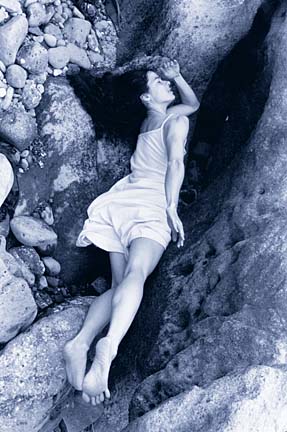


In the gestures of butoh, Lori Ohtani found the medium she had been searching for. Trained in the visual arts, she was finishing studies for her BFA degree from the University of Hawai'i when she discovered self-expression through movement, first in a modern dance class, although she says she never felt totally at ease on a stage until she discovered butoh. Bodies in motion
By Nadine Kam
nkam@Starbulletin.com"I was so drawn to butoh. Other forms have real, real specific steps to adhere to, maybe even a specific body type you have to adhere to, but butoh is really open to anybody. If you can walk, you can dance. You can do butoh."
Now, inspired by anything from books to scientific theory, she has traded paintbrush and palette for creating pictures in three dimensions, with the stage as her canvas.
Tomorrow and Sunday, the diminutive dancer, founder of Tangentz Performing Group, will perform in a concert entitled "Pulse," also featuring students of the Japan Cultural Center of Hawaii butoh classes and guest artist Maureen Freehill.

Tangentz will perform a reworking of "Equinox," a piece that Ohtani premiered at Hawaii Theatre in March, as one of the works featured in Tau Dance Theatre's "Women's Night Out" concert. This time, the piece will get a gender makeover as men are added to the performance, just one more move that's OK in the world of butoh."When I restage a piece, it's always different, Ohtani said. "I like work to progress, not to be static. That's one thing about butoh, it shouldn't be static. I really like the saying: you can be still but always moving."
Originally conceived as a spare art form reflecting the "utter darkness" of a post World War II Japan, modern butoh has evolved to encompass many forms of expression, including poetry and visual arts.
"It reminds me of the feelings I would get if I were painting or drawing," Ohtani said. "It's very organic. Some of the movements came about from trying to search for the real human behind the facade. It feels very free, unconstricted and natural. It's a very pure, honest state."
In creating her works, Ohtani strives to achieve a truth in presenting carefully researched ideas. "Equinox" represents months of research into the two days of the year when day and night are of equal length. Studying the phenomenon led her to brush up on the theories of Nicolaus Copernicus, the mathemetician and astronomer raised a fury in the 16th century when he posited it was the sun, not earth, at the center of the universe.
At the heart of the dance is the struggle to achieve a balance that nature has perfected, but man must work to achieve.
What: Butoh performances by Tangentz, Maureen Freehill and Japanese Cultural Center of Hawaii students "Pulse"
Where: JCCH Art Gallery, 2454 S. Beretania St.
Tickets: $12 general, $10 for JCCH members, $8 for students and seniors, $15 at the door (validated parking $2)
Call: 988-4290
In rehearsals, the dancers rotate slowly within their own personal space before coming together in a primal struggle that involves pushing at each other in an attempt to find balance which cannot be achieved through force. Push one way, and the dancer overcompensates on his opposite side, further skewing his posture.
"What I want the audience to come away with is a kind of change in themselves; to strike a chord, whether it's discomfort or joy, or move them in a way they haven't felt before," Ohtani said.
In researching future subjects for her work, she is an avid reader. And not all the material is high-brow or challenging. "People magazine, yeah, I'll read anything, actually," she said.
"I recently read a review about a book on Howard Hughes and his little obsessions, which would provide lots of material for dance, like, there were two or three pages on how to open a can of soup. I don't know how many steps there were, but I think it was about 40. There are a lot of ideas I come across."
Click for online
calendars and events.